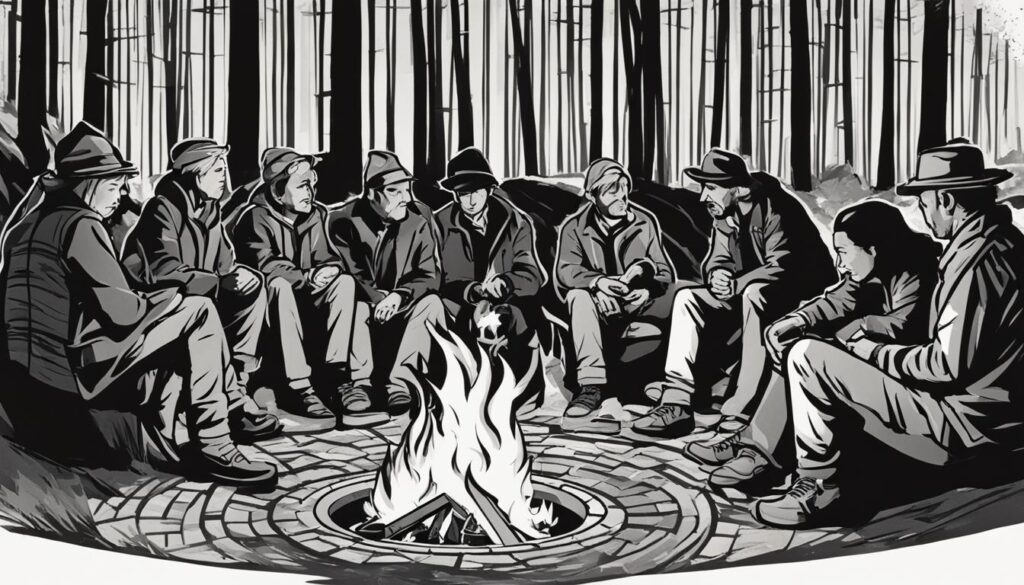Native American culture is known for its rich oral tradition, relying on verbal language to share history, customs, rituals, and legends. These powerful tales, passed down from tribal elders to younger generations, breathe life into the culture, preserve their traditions, and teach life lessons. On the other hand, written scriptures are used by other cultures to document their history and beliefs. This section will explore the profound differences between the Native American oral tradition and written scriptures from various perspectives.
Key Takeaways:
- The Native American oral tradition is a vital tool for passing down traditions, customs, and knowledge.
- Native American stories encompass myths, legends, and hero tales, honoring their relationship with nature and spirit mentors.
- Native American stories carry instructions for ceremonies, rituals, traditional living, and provide insights into various aspects of life.
- Written scriptures in other cultures serve as fixed texts, while Native American stories are fluid and shaped by each storyteller.
- Native American spirituality embraces a unified view of reality, blurring the lines between the spiritual and natural worlds.
Importance of Native American Storytelling
Native American storytelling holds a significant place in Indigenous cultures, serving as a powerful means of preserving traditions, sharing knowledge, and maintaining a connection to their heritage. Through Indigenous oral narratives, the rich tapestry of Native American literature comes to life, weaving together stories, legends, and myths that have been handed down through generations.
At the heart of Native American storytelling lies the desire to pass down cultural wisdom and teachings. These stories serve as a way to educate younger generations about the history, customs, and values of their tribe, while also celebrating the relationship between humans, nature, and the spiritual realm. Indigenous oral narratives convey ethical principles, ecological knowledge, and the interconnectedness of all living beings.
The practice of Native American storytelling also holds deep cultural significance. It represents an oral tradition that is not only a means of entertainment but also a way to honor and preserve the unique cultural identity of each tribe. Through storytelling, Native Americans can share their experiences, beliefs, and worldview, creating a sense of unity and connection within their communities.
Table: Importance of Native American Storytelling
| Benefits | Description |
|---|---|
| Preservation of traditions | Storytelling allows for the transmission of cultural knowledge from one generation to another, ensuring the survival of traditions and customs. |
| Connection to heritage | Through storytelling, Native Americans maintain a strong connection to their cultural roots, preserving their unique heritage and identity. |
| Education and teachings | Storytelling serves as a platform for sharing important life lessons, ethical principles, and ecological knowledge with younger generations. |
| Celebration of interconnectedness | Native American storytelling highlights the deep connection between humans, nature, and the spiritual realm, fostering a sense of unity and respect for all living beings. |
Native American storytelling continues to play an essential role in Indigenous communities, keeping their culture alive and vibrant. It is a testament to the power of oral tradition and the enduring impact of storytelling in fostering cultural preservation and identity.
Cultural Significance of Native American Stories
Native American stories hold immense cultural significance, serving as repositories of ethical principles and ecological knowledge. These stories are more than just entertaining narratives; they provide profound insights into the interconnectedness of all life forms and the importance of honoring the natural world.
Embedded within these stories are ethical principles that guide individual behavior and communal harmony. Native American stories teach values such as respect, humility, compassion, and gratitude, emphasizing the importance of maintaining a balanced relationship with both the human and non-human realms.
Additionally, Native American stories offer a wealth of ecological knowledge. They contain detailed observations and understandings of the natural world, including animal behaviors, plant uses, and environmental phenomena. These stories often serve as instructional guides, providing practical wisdom on sustainable hunting, agriculture, and land management practices.
The Importance of Native American Stories in Cultural Preservation
The preservation of Native American culture relies heavily on the oral transmission of their stories. These stories encapsulate the collective history, values, and spiritual beliefs of the tribes, ensuring their continuity across generations. Through the act of storytelling, cultural knowledge is passed down from elders to younger members, fostering a sense of identity, belonging, and pride.
Furthermore, Native American stories provide a means of reclaiming and revitalizing cultural heritage. As colonization and forced assimilation disrupted traditional practices, storytelling became a powerful tool for cultural resurgence. Today, Native American communities actively engage in storytelling initiatives to preserve and revive their cultural traditions, reconnecting with ancestral wisdom and strengthening their cultural resilience.
| Native American Stories: Cultural Significance | Ethical Principles | Ecological Knowledge |
|---|---|---|
| Hold profound cultural significance | Teach values of respect, humility, compassion, and gratitude | Contain detailed observations of the natural world |
| Guide individual behavior and communal harmony | Promote balanced relationships with all life forms | Provide practical wisdom on sustainable practices |
| Preserve ancestral history, values, and spiritual beliefs | Foster a sense of identity, belonging, and pride | Revive cultural heritage and traditions |
Native American Oral Tradition vs. Written Scriptures
The difference between Native American oral tradition and written scriptures lies in both the means of transmission and the inherent fluidity of the stories. The oral tradition of Native American storytelling allows for a dynamic exchange between the storyteller and the audience, creating an immersive experience that brings the narratives to life. These stories are passed down from generation to generation, adapting and evolving with each retelling, reflecting the unique perspectives and interpretations of the storytellers.
In contrast, written scriptures in other cultures offer a fixed record of religious beliefs and moral principles. These texts provide a permanent form of documentation, preserving the teachings and traditions in a standardized format. While written scriptures are considered unchangeable, Native American oral tradition allows for the flexibility to adapt the stories to fit the context and needs of the present moment. The absence of written scriptures in Native American traditions emphasizes the importance of participating in the cultural practices to learn and preserve the traditions.
By embracing the fluidity of oral tradition, Native American storytelling enables a deeper connection to the cultural heritage and provides a space for ongoing interpretation and reinterpretation. The stories become living entities, embodying the collective wisdom and experiences of the tribe. This fluidity allows the stories to remain relevant and adaptable, ensuring that they continue to resonate with each new generation.
| Native American Oral Tradition | Written Scriptures |
|---|---|
| Passed down through generations | Fixed text |
| Adaptable and shaped by each storyteller | Considered unchangeable |
| Encourages audience participation | Provides a permanent record |
Native American Spirituality and Beliefs
Native American religions have a unique perspective on spirituality, emphasizing a unified view of reality that blurs the lines between the spiritual and natural worlds. Unlike many organized religions, Native American spirituality lacks fixed rules and regulations, offering a more fluid and adaptable approach to religious beliefs and practices. Central to Native American spirituality is the belief in a divine Creator, which can take various forms, including a single deity, a group of gods, or an impersonal force. This belief in a higher power guides their connection to the world and their place within it.
Native American spirituality places great importance on ethical principles and the balance between humans and the natural environment. Rather than strict laws, these principles are seen as guidelines for living a virtuous life and maintaining harmony with all living beings. Native American stories and teachings often convey these tenets, emphasizing the interconnectedness and interdependence of all life forms. By honoring and respecting the natural world, Native Americans strive to maintain a harmonious relationship with their surroundings, recognizing their role as caretakers of the earth.
Example Table: Comparison of Native American and Western Religious Beliefs
| Aspect | Native American Spirituality | Western Religions |
|---|---|---|
| Belief in a Divine Creator | Varied interpretations, often non-anthropomorphic | Belief in a singular, anthropomorphic God |
| Tenets and Regulations | Fluid and adaptable principles | Fixed rules and regulations |
| Connection to Nature | Emphasizes harmony and interdependence | Views nature as separate from humans |
| Role of Humans | Caretakers and stewards of the earth | Domination and mastery over nature |
The lack of fixed principles in Native American spirituality allows individuals to explore their personal connection with the divine Creator and develop their unique spiritual path. This fluidity enables Native Americans to adapt their beliefs and practices to the ever-changing circumstances of life. The absence of written scriptures also reinforces the oral transmission of spiritual teachings and stories, fostering a deep and personal connection between the storyteller and the audience. Through storytelling, Native Americans share their spiritual wisdom, preserving their cultural heritage and passing on valuable lessons from one generation to the next.
Native American Literature and the Importance of Oral Tradition
Native American literature holds a significant place in the cultural preservation of Indigenous communities. It is deeply rooted in the oral tradition, where stories, songs, and poems are passed down through generations. This form of transmission not only ensures the continuity of cultural knowledge but also helps to keep their traditions alive. The importance of oral tradition in Native American literature cannot be overstated, as it serves as a vehicle for transmitting values, beliefs, and the cultural identity of these communities.
Through the preservation of oral tradition, Native American literature provides valuable insights into the worldview, history, and experiences of Indigenous peoples. These stories reflect their deep connection with the natural world and the spiritual beliefs that guide their lives. By sharing their narratives orally, Native Americans maintain a sense of communal identity, fostering a collective memory that transcends individual experiences. The oral transmission of cultural knowledge allows for the intergenerational transfer of wisdom, ensuring that future generations have access to the rich heritage of their ancestors.
The importance of oral tradition in preserving Native American culture is further exemplified by ongoing efforts to document and record these stories for future generations. While the tradition of storytelling may be less common today, various initiatives aim to capture and preserve these narratives in written form. This allows for wider dissemination and accessibility, ensuring that the profound insights and teachings embedded within Native American literature reach a broader audience.

Conclusion
The Native American oral tradition and written scriptures represent two distinct and profound forms of storytelling and cultural preservation. While written scriptures provide a fixed record of religious beliefs and moral principles in other cultures, the Native American oral tradition relies on verbal language to pass down history, customs, and legends.
The cultural significance of Native American stories lies in their ability to honor all life, serve as teaching tools, and provide insights into various aspects of tribal life. These stories carry instructions for ceremonies and rituals, offer ecological knowledge, and showcase a deep connection to the natural world.
Unlike written scriptures, Native American stories are fluid and adaptable, shaped by each storyteller, and representing a symbiotic connection between the storyteller and the audience. The absence of written scriptures emphasizes the importance of active participation in cultural practices to learn and preserve traditions, creating a more immersive and interactive experience.
Understanding and appreciating the differences between Native American oral tradition and written scriptures is crucial in embracing the diversity and richness of human storytelling traditions. The oral tradition serves as a means of cultural preservation, allowing Native Americans to honor their history, customs, and relationship with nature. By recognizing the value of both forms of storytelling, we can gain a deeper appreciation for the wisdom and resilience of indigenous cultures.
FAQ
What is the difference between Native American oral tradition and written scriptures?
Native American oral tradition relies on verbal language to pass down history, customs, and legends, while written scriptures are fixed texts used to document religious beliefs and moral principles.
How do Native American stories contribute to cultural preservation?
Native American stories serve as a means of remaining connected to their heritage and homeland, preserving traditions, and teaching life lessons.
What themes are common in Native American stories?
Native American stories often revolve around honoring all life, including plants, animals, and ancestors, and provide insights into various aspects of life such as child-rearing, friendship, love, hunting routes, and family lineage.
How does the transmission of Native American stories differ from written scriptures?
Native American stories are primarily passed down through oral tradition, allowing for flexibility and adaptability, while written scriptures provide a permanent record.
How does Native American spirituality differ from other religious systems?
Native American spirituality lacks fixed rules and regulations, treating moral principles as guidelines rather than absolute laws.
What role does oral tradition play in Native American literature?
Oral tradition is deeply rooted in Native American literature, with stories, songs, and poems being passed down through generations, preserving the culture and keeping traditions alive.
Why is understanding the differences in storytelling forms across cultures important?
Understanding and appreciating the diversity and richness of storytelling forms allows for a deeper appreciation of human traditions and cultural heritage.
 Skip to main content
Skip to main content


